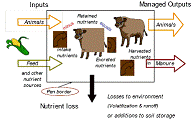Biological Systems Engineering, Department of

Department of Agricultural and Biological Systems Engineering: Presentations and White Papers
Date of this Version
October 2003
Document Type
Article
Abstract
A committee was formed consisting of both animal scientists and agricultural engineers to evaluate and update current ASAE standards. An intake minus retention model was developed to estimate nutrient excretion. This approach allows users (producers, engineers, etc.) to develop site specific information based on known variables such as protein or phosphorus content of diets and cattle performance. This approach illustrates the importance of nutrition on nutrient excretion in livestock operations. Our focus is for feedlot cattle and updates excretion of dry matter (DM or total solids), organic matter (OM or volatile solids), N, P, Ca, K, Na, Mg, S, Cu, Fe, Se, Zn, Mn, Co, and I.
Based on survey data of 19 nutritionists that control formulation for approximately 50% of the cattle fed in the U.S., the average diet contains 13.3% crude protein (2.13% N) and 0.31% P. Based on performance of approximately 14 million cattle fed from 1996 to 2002, the "average" steer is fed 153 days. This steer weighs 338 kg at arrival, finishes at 554 kg, gains 1.42 kg per day and consumes 8.84 kg of DM each day. With the "average" diet concentrations and consumption amounts for feedlot steers fed in the U.S, we can accurately estimate nutrient intake. Retention of nutrients in the animal during growth is the other critical component to using an intake minus retention based model for excretion. Retention of nutrients was calculated from gains using the 1996 National Research Council Nutrient Requirements of Beef Cattle to calculate N, P, and Ca retention. Retention of other minerals was based on 10% of intake being retained when fed at requirements.
Average excretion values for DM, OM, N, P, Ca, K, Na, Mg, S, Cu, Fe, Se, Zn, Mn, Co, and I expressed for the entire 153 day period or per finished steer are 270 kg, 220 kg, 24.8 kg, 3.2 kg, 7.8 kg, 9.2 kg, 1.8 kg, 2.7 kg, 2.4 kg, 19.4 g, 68.9 g, 0.27 g, 96.1 g, 49.1 g, 0.31 g, and 0.93 g, respectively. In some cases, the new values are much lower than current standards. For example, P excretion is 6.3 kg for the average steer weighing 446 kg (average live weight) fed 153 days based on the previous standard. The revised P excretion based on intake minus retention is 3.2 kg or 50.8% of the previous standard. The proposed excretion values should allow for more accurate planning and allow users to tailor excretion to site-specific situations by incorporating cattle performance, days on feed, weights, and nutrient content of diets.
While the previous standard does not account for variation, considerable agreement was found between the current intake minus retention model for excretion and the previous standard. Excretion of DM, OM, P, and Ca were identical between the average excretion estimate using the current model and the previous standard for calves gaining 0.9 kg per day, weighing 295 kg.


Comments
Paper presented at the Ninth International Animal, Agricultural and Food Processing Wastes Proceedings of the 12-15 October 2003 Symposium (Research Triangle Park, North Carolina USA), Pp. 269-276, Publication Date 12 October 2003. ASAE Publication Number 701P1203, ed. Robert T. Burns. Copyright © 2003 G. Erickson, B. Auvermann, R. Eigenberg, L. Greene, T. Klopfenstein, R. Koelsch.